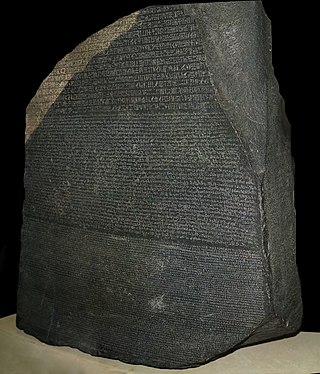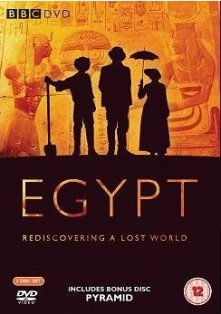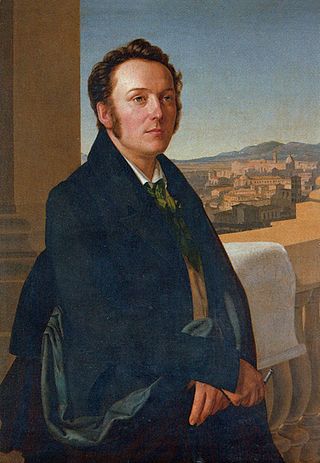Related Research Articles

The Rosetta Stone is a stele of granodiorite inscribed with three versions of a decree issued in 196 BC during the Ptolemaic dynasty of Egypt, on behalf of King Ptolemy V Epiphanes. The top and middle texts are in Ancient Egyptian using hieroglyphic and Demotic scripts, respectively, while the bottom is in Ancient Greek. The decree has only minor differences across the three versions, making the Rosetta Stone key to deciphering the Egyptian scripts.

Ancient Egyptian hieroglyphs were the formal writing system used in Ancient Egypt for writing the Egyptian language. Hieroglyphs combined ideographic, logographic, syllabic and alphabetic elements, with more than 1,000 distinct characters. Cursive hieroglyphs were used for religious literature on papyrus and wood. The later hieratic and demotic Egyptian scripts were derived from hieroglyphic writing, as was the Proto-Sinaitic script that later evolved into the Phoenician alphabet. Egyptian hieroglyphs are the ultimate ancestor of the Phoenician alphabet, the first widely adopted phonetic writing system. Moreover, owing in large part to the Greek and Aramaic scripts that descended from Phoenician, the majority of the world's living writing systems are descendants of Egyptian hieroglyphs—most prominently the Latin and Cyrillic scripts through Greek, and the Arabic and Brahmic scripts through Aramaic.

Jean-François Champollion, also known as Champollion le jeune, was a French philologist and orientalist, known primarily as the decipherer of Egyptian hieroglyphs and a founding figure in the field of Egyptology. Partially raised by his brother, the scholar Jacques Joseph Champollion-Figeac, Champollion was a child prodigy in philology, giving his first public paper on the decipherment of Demotic in his late teens. As a young man he was renowned in scientific circles, and read Coptic, Ancient Greek, Latin, Hebrew and Arabic.

Tanis or San al-Hagar is the Greek name for ancient Egyptian ḏꜥn.t, an important archaeological site in the northeastern Nile Delta of Egypt, and the location of a city of the same name. It is located on the Tanitic branch of the Nile, which has long since silted up.

François Auguste Ferdinand Mariette was a French scholar, archaeologist and Egyptologist, and the founder of the Egyptian Department of Antiquities, the forerunner of the Supreme Council of Antiquities.

The Council of Ancients or Council of Elders was the upper house of the French legislature under the Constitution of the Year III, during the period commonly known as the Directory, from 22 August 1795 until 9 November 1799, roughly the second half of the period generally referred to as the French Revolution.

Canopus, also known as Canobus, was an ancient Egyptian coastal town, located in the Nile Delta. Its site is in the eastern outskirts of modern-day Alexandria, around 25 kilometers (16 mi) from the center of that city. Canopus was located on the western bank at the mouth of the westernmost branch of the Delta – known as the Canopic or Heracleotic branch. It belonged to the seventh Egyptian Nome, known as Menelaites, and later as Canopites, after it. It was the principal port in Egypt for Greek trade before the foundation of Alexandria, along with Naucratis and Heracleion. Its ruins lie near the present Egyptian town of Abu Qir.
The year 1822 in archaeology involved some significant events.
Below are notable events in archaeology that occurred in 1906.

Egypt is a BBC television docudrama serial portraying events in the history of Egyptology from the 18th through early 20th centuries. It originally aired on Sunday nights at 9 pm on BBC1 in 2005. The first two episodes explored the work of Howard Carter and his archaeological quest in Egypt in the early part of the twentieth century. The next two episodes focused on the eccentric explorer "The Great Belzoni" played here by Matthew Kelly. The final two episodes dramatise the discovery and deciphering of the Rosetta Stone by Jean-François Champollion.

The writing systems used in ancient Egypt were deciphered in the early nineteenth century through the work of several European scholars, especially Jean-François Champollion and Thomas Young. Ancient Egyptian forms of writing, which included the hieroglyphic, hieratic and demotic scripts, ceased to be understood in the fourth and fifth centuries AD, as the Coptic alphabet was increasingly used in their place. Later generations' knowledge of the older scripts was based on the work of Greek and Roman authors whose understanding was faulty. It was thus widely believed that Egyptian scripts were exclusively ideographic, representing ideas rather than sounds. Some attempts at decipherment by Islamic and European scholars in the Middle Ages and early modern times acknowledged the script might have a phonetic component, but perception of hieroglyphs as purely ideographic hampered efforts to understand them as late as the eighteenth century.

Gustav Seyffarth was a German-American Egyptologist, born in Uebigau, in the Electorate of Saxony.

The Philae obelisk is one of a pair of twin obelisks erected at Philae in Upper Egypt in the second century BC. It was discovered by William John Bankes in 1815, who had it brought to Kingston Lacy in Dorset, England, where it still stands today. The Greek and Egyptian hieroglyphic inscriptions on the obelisk played a role in the decipherment of ancient Egyptian hieroglyphs.
The decade of the 1710s in archaeology involved some significant events.
The decade of the 1750s in archaeology involved some significant events.

The National Archaeological Museum of Florence is an archaeological museum in Florence, Italy. It is located at 1 piazza Santissima Annunziata, in the Palazzo della Crocetta.

The Search for Ancient Egypt is a 1986 illustrated monograph on the history of the rediscovery of ancient Egypt and of Egyptology. Written by the French Egyptologist Jean Vercoutter, and published by Éditions Gallimard as the first volume in their pocket collection "Découvertes". The book was awarded a literary prize by the Fondation de France in 1987.
This page lists major events of 2021 in archaeology.
The archaeology of ancient Egypt is the study of the archaeology of Egypt, stretching from prehistory through three millennia of documented history. Egyptian archaeology is one of the branches of Egyptology.
References
- ↑ "Frampton". Historic England research records. Historic England. 2012. Retrieved 2024-07-01– via Heritage Gateway.
- ↑ "Key objects of the collection". The Roman Baths. Bath: Roman Baths. 24 October 2014. Retrieved 2016-07-27.
- ↑ Read, Allen Walker (1930). "The Disinterment of Milton's Remains". Publications of the Modern Language Association of America . 45 (4): 1050–68. doi:10.2307/457826. JSTOR 457826. S2CID 163450400.
- ↑ History Today. 68 (12): 23. December 2018.
{{cite journal}}: Missing or empty|title=(help) - ↑ "Account about opening King John's tomb". The British Library. Retrieved 8 June 2017.
- ↑ Webster, Leslie (1986). "Anglo-Saxon England AD 400–1100". In Longworth, Ian; Cherry, John (eds.). Archaeology in Britain since 1945 . London: British Museum. p. 121. ISBN 0-7141-2035-9.
- ↑ Royal Academy of Arts (2007). Making History: Antiquarians in Britain 1707-2007. London. p. 99.
{{cite book}}: CS1 maint: location missing publisher (link) - ↑ "BBC - History - Jean-François Champollion". BBC. Retrieved 17 May 2017.
- ↑ Bierbrier, Morris L. (2008). Historical Dictionary of Ancient Egypt. Scarecrow Press. p. 257. ISBN 9780810862500.
- ↑ "Jean-Jacques Barthelemy - French archaeologist". Encyclopedia Britannica. Retrieved 17 May 2017.